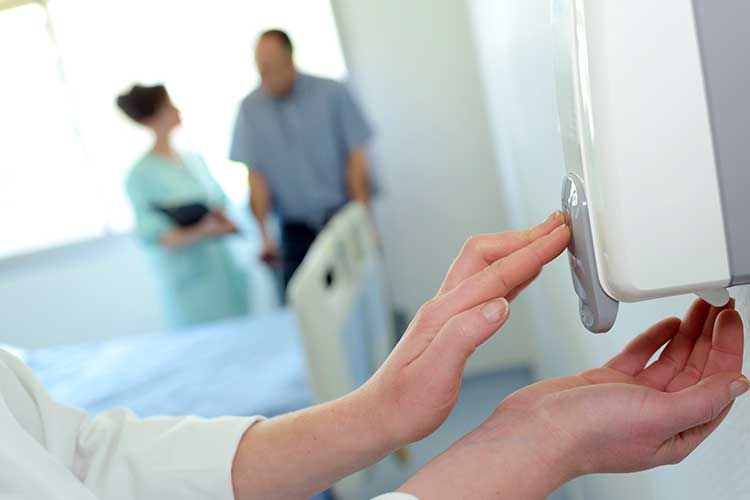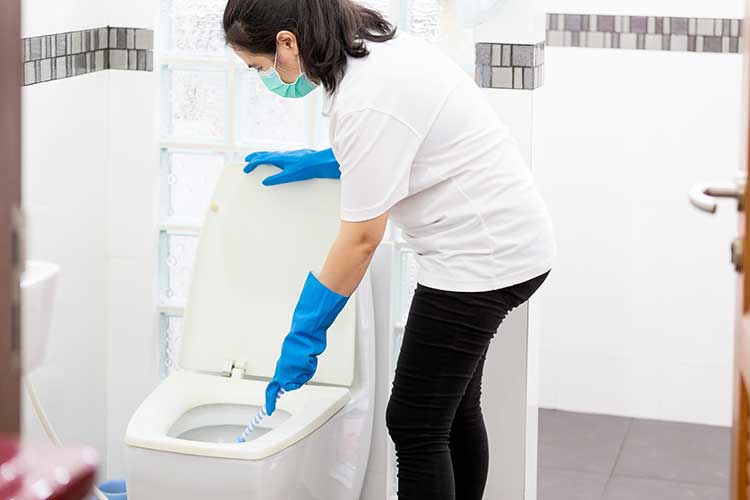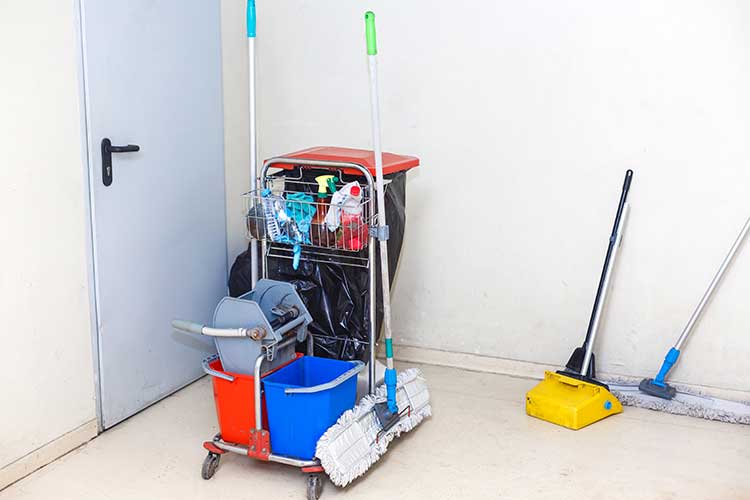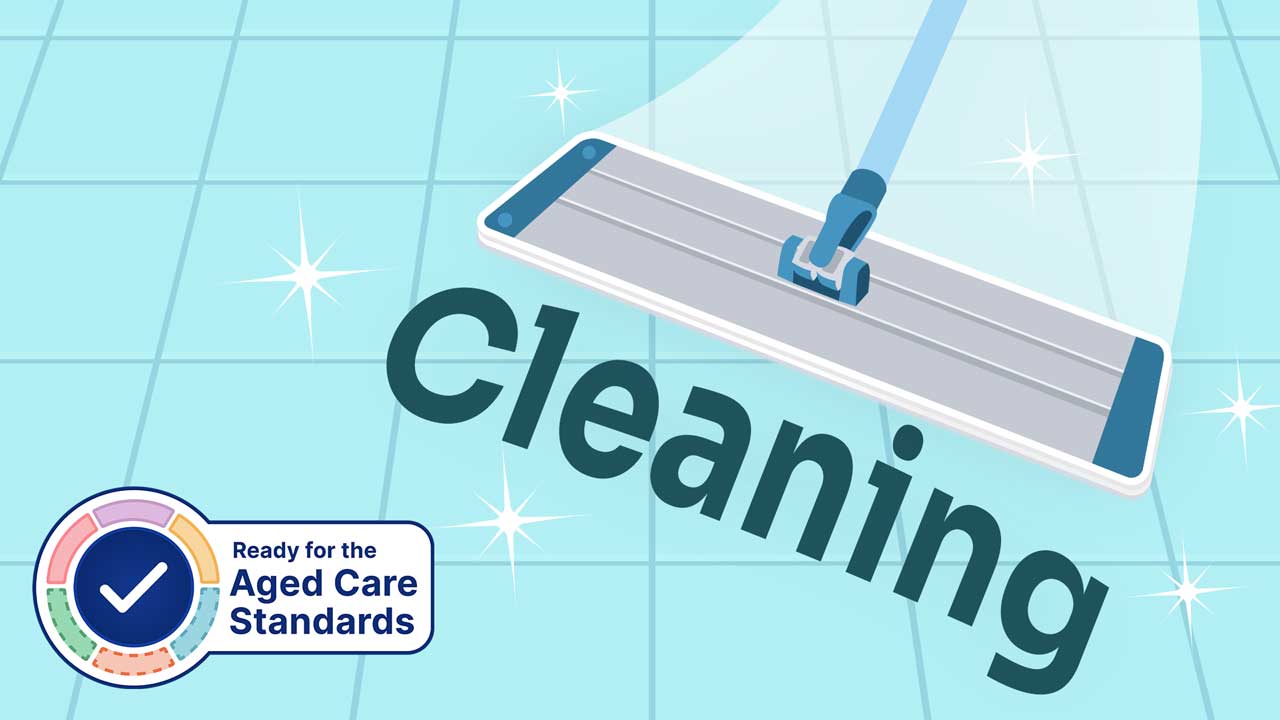It’s crucial to ensure surfaces and environments in healthcare settings are cleaned thoroughly and properly in order to prevent infection transmission and keep patients, staff and visitors safe and healthy.
Healthcare-associated infections (HAIs) can be transmitted in any healthcare setting, with approximately 165,000 cases occurring per year. HAIs can potentially lead to poor patient outcomes, increased healthcare costs and longer patient stays in hospital (NHMRC 2024).
HAIs also pose a risk to staff or any other people who enter a healthcare facility (NHMRC 2024).
Therefore, the effective implementation of infection prevention and control is crucial to ensure that high-quality healthcare is provided to patients and a safe working environment is maintained for staff (NHMRC 2024).
Successful infection prevention and control relies on a sound understanding of the modes of transmission and when preventative measures should be taken. This is the responsibility of not only healthcare staff but also visitors, patients, carers and administrators (NHMRC 2024).
Environment Cleaning Under the Strengthened Aged Care Quality Standards
Standard 4: The Environment - Outcome 4.1b: Environment and equipment in a service environment under the strengthened Aged Care Quality Standards (Action 4.1.1b) requires aged care service environments to be regularly cleaned (ACQSC 2024).
Additionally, Outcome 4.2: Infection prevention and control (Action 4.2.1) requires aged care providers to establish an infection prevention and control system that outlines standard and transmission-based precautions appropriate for the care setting, including cleaning (ACQSC 2024).

How are Healthcare-Associated Infections Transmitted?
Many infectious agents, comprising bacteria, viruses, fungi and parasites, exist in healthcare settings, usually originating from human sources (patients and staff). They are most commonly transmitted to others through contact (direct or indirect), droplet or airborne routes (NHMRC 2024).
The spread of these infectious agents between susceptible ‘hosts’ is a process known as the chain of infection, and preventing transmission relies on breaking the chain at any of its six links:
- Infectious agent
- Reservoir
- Portal of exit
- Mode of transmission
- Portal of entry
- Susceptible host.
(NHMRC 2024)
For more information about infectious agents and the chain of infection, refer to Infectious Diseases: How Do You Break the Chain?.
Standard and Transmission-Based Precautions
Successful infection prevention and control involves the implementation of the following two-tiered approach:
Standard precautions:
- Basic measures of infection prevention and control that should be used for all patients regardless of their infectious status
- They should be in practice all of the time in order to achieve a basic level of infection control
- They include:
- Appropriate hand hygiene as per the 5 Moments for Hand Hygiene
- Appropriate PPE use according to the task being undertaken and level of risk
- Safe use and disposal of sharps
- Waste management
- Linen handling
- Respiratory hygiene and cough etiquette
- Aseptic technique
- Environmental cleaning
- Reprocessing of equipment and instruments.
(NHMRC 2024)
Transmission-based precautions:
- Additional measures designed to interrupt a specific infectious agent and its mode of transmission
- Used to control the risk of infection risk from patients who are suspected or confirmed to be in contact with infectious agents transmitted by contact, airborne or droplet routes
- Used during outbreaks
- Used if standard precautions alone are insufficient
- They may include:
- Isolation in a single room
- Enhanced cleaning of the room with detergent and disinfectant
- Additional PPE
- Patient-dedicated equipment
- Appropriate air handling
- Reduced patient transfer.
(NHMRC 2024)
Note: Transmission-based precautions must be used in addition to, not instead of, standard precautions.
Environmental Surface Cleaning

Environmental surface cleaning relates to the cleaning of surfaces and objects to reduce contamination from infectious agents that may be present and, as a result, prevent cross-infection (SA Health 2025).
The act of cleaning aims to remove foreign materials, including dust, soil, blood, secretions, excretions and micro-organisms from surfaces and objects. This is achieved through a combination of water, detergent and friction (SA Health 2021).
According to the Australian Guidelines for the Prevention and Control of Infection in Healthcare (2024), it’s good practice to clean as follows:
- Frequently touched surfaces (e.g. door handles, bed rails, water taps and light switches) should be cleaned daily with a detergent solution, and when visibly soiled, and after every known contamination.
- Minimally touched surfaces (e.g. floors, ceilings, walls, blinds) should be cleaned when visibly soiled and immediately after spillage.
(NHMRC 2024; ACSQHC 2023)
Additionally, wet areas such as toilets, sinks, baths, showers and basins should be cleaned at least daily, and more frequently if needed (VIC DoH 2023).
Cleaning Chemicals
There are two types of chemicals used for cleaning in healthcare settings:
- Detergents remove dirt and organic matter. They are used as a general cleaning agent and are usually sufficient for most surfaces.
- Disinfectants can kill or deactivate infectious agents, but they do not have a cleaning effect and may be inactivated by soil. Therefore, to function effectively, they should be used in conjunction with detergents when necessary, but not as a general cleaning agent.
(SA Health 2021; ACSQHC 2023)
Cleaning solutions should be prepared immediately before use (VIC DoH 2023).
Remember to follow workplace health and safety instructions and the manufacturer’s recommendations before using a disinfectant (VIC DoH 2023).
Cleaning Equipment
Generally, the following principles apply to equipment used for cleaning:
- Equipment that disperses dust (e.g. a broom) or generates aerosols (e.g. a spray bottle) should be avoided as it may cause irritation
- Single-use cleaning items are preferable
- Reusable cleaning items (solutions, water, buckets, cloths and mop heads) should be changed after each use and changed immediately if used to clean a body substance spill
- Buckets should be emptied, washed with detergent and warm water, rinsed with hot water and dried upside-down between uses
- Mops should be laundered or washed with detergent and warm water, rinsed with hot water and dried between uses.
(SA Health 2021; VIC DoH 2023)

Cleaning Technique
It’s important to adhere to appropriate cleaning techniques, as incorrect cleaning may encourage the spread of microorganisms rather than remove them (SA Health 2021). The following principles generally apply:
- Cleaning should start at the cleanest areas first (minimally touched and lightly soiled) before moving to the dirtiest areas (frequently touched and heavily soiled) last. For example, in a bathroom, the toilet should generally be cleaned last
- Cleaning should start at high-reach surfaces before moving to low-reach services
- Dusting techniques should not disperse dust (dust high-reach areas first and use a damp cloth)
- Wipe surfaces in an S-shaped motion
- Cleaning should be performed in a methodical manner
- When using cloths and a bucket:
- Avoid double-dipping used cloths into a bucket where there are clean cloths, as this will contaminate the clean cloths
- Rotate and fold cloths as they are being used in order to maximise their use
- Remember that frequently touched surfaces may require more cloths than minimally touched surfaces.
(SA Health 2021; ACSQHC 2023)
The Cleaning Process
There are generally two processes used for environmental cleaning in healthcare that you can choose from: the two-step process and the two-in-one-step process (ACSQHC 2023).
Two-Step Process
- Clean all surfaces using a natural detergent and water to remove dust and dirt. Allow the surfaces to completely dry.
- If any surfaces have been contaminated by blood, body fluids or infectious agents, clean them again using a disinfectant solution. Once again, allow the surfaces to completely dry.
(ACSQHC 2023)
Two-in-One-Step Process
Clean all surfaces using a single cleaning solution that contains both a natural detergent and a disinfectant. Allow the surfaces to dry completely.
(ACSQHC 2023)
Types of Cleans
| Standard clean: | The minimum amount of cleaning that should be routinely conducted regardless of whether surfaces appear visibly dirty or not. |
| Transmission-based clean: | Conducted when there are patients on transmission-based precautions.
|
| Discharge (terminal) clean: | Cleaning of specific elements after the permanent vacation of a patient (e.g. due to discharge, transfer or death).
|
| Spot and spill clean: | To be performed whenever a surface is visibly soiled or there is a body fluid spillage. |
(SA Health 2021)
Remember to refer to your organisation’s policies and procedures for environmental cleaning.
Test Your Knowledge
Question 1 of 3
What is the correct sequence for cleaning according to best practice?
Topics
Further your knowledge
References
- Aged Care Quality and Safety Commission 2024, Standard 4: The Environment, Australian Government, viewed 11 April 2025, https://www.agedcarequality.gov.au/sites/default/files/media/guidance-material-for-the-strengthened-aged-care-quality-standards-standard-4.pdf
- Australian Commission on Safety and Quality in Health Care 2023, Environmental Cleaning: Information for Cleaners, Australian Government, viewed 11 April 2025, https://www.safetyandquality.gov.au/sites/default/files/2021-06/environmental_cleaning_information_for_cleaners_fact_sheet.pdf
- National Health and Medical Research Council 2024, Australian Guidelines for the Prevention and Control of Infection in Healthcare, Australian Government, viewed 11 April 2025, https://www.safetyandquality.gov.au/publications-and-resources/resource-library/australian-guidelines-prevention-and-control-infection-healthcare
- SA Health 2025, Environmental Hygiene in Healthcare, Government of South Australia, viewed 11 April 2025, https://www.sahealth.sa.gov.au/wps/wcm/connect/public+content/sa+health+internet/clinical+resources/clinical+programs+and+practice+guidelines/infection+and+injury+management/healthcare+associated+infections/prevention+and+management+of+infections+in+healthcare+settings/environmental+hygiene+in+healthcare
- SA Health 2021, Cleaning Standard for South Australian Healthcare Facilities, Government of South Australia, viewed 11 April 2025, https://www.sahealth.sa.gov.au/wps/wcm/connect/18741180499970f0891e8faa8650257d/SA-Health-cleaning-standard-2014_%28v1.1%29-cdcb-ics-20180301.pdf?MOD=AJPERES&CACHEID=ROOTWORKSPACE-18741180499970f0891e8faa8650257d-mUgA.-J
- Victoria Department of Health 2023, Cleaning and Waste Disposal Procedures - Infection Control, Victoria State Government, viewed 11 April 2025, https://www.health.vic.gov.au/infectious-diseases/cleaning-and-waste-disposal-procedures-infection-control
 New
New 

